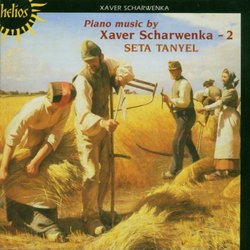| All Artists: Scharwenka, Tanyel Title: Piano Music 2 Members Wishing: 1 Total Copies: 0 Label: Hyperion UK Release Date: 10/8/2002 Album Type: Import Genre: Classical Styles: Chamber Music, Historical Periods, Classical (c.1770-1830) Number of Discs: 1 SwapaCD Credits: 1 UPC: 034571151328 |
Search - Scharwenka, Tanyel :: Piano Music 2
CD Details |
CD ReviewsPleasant late romantic music for the piano J Scott Morrison | Middlebury VT, USA | 04/07/2003 (4 out of 5 stars) "Many young pianists of my generation cut their teeth on one or another of Xaver Scharwenka's Polish Dances; he composed about thirty of them. The Op. 3, No. 1 was immensely popular, selling millions of copies and that's the one I learned to play when I was about ten or so. On this release are the two Polish Dances, Op. 29, and they are mazurkas in all but name. They are lively and set your toe tapping as played by Seta Tanyel.This CD is a reissue of a disc that initially appeared on the now-defunct Collins Classics. A number of labels seem to be picking up these old Collins releases - I recently reviewed their recording of Britten's 'Albert Herring' which has now appeared on Naxos - and in this case, Helios (a sub-label of Hyperion) is issuing all of Tanyel's performances of Scharwenka's piano music. The Sonatine in E minor, Op. 51, No. 1 is one of a pair of pieces that are rather more classical in style than the sonatas. It is not surprising, therefore, that there is a minuet and one even hears Alberti basses at times! This ten-minute piece is fairly negligible but might be useful for intermediate piano students.There are two major pieces here, the Romanzero and the big Second Sonata. The Romanzero, Op. 33, is actually a four-movement sonata; I've never encountered the name 'Romanzero' before, but apparently Scharwenka wrote several others as well. This one sounds a lot like Schumann; indeed, the churning left hand accompanying the second theme in the first movement sounds very similar to that of the first movement of the Schumann 'Fantasie in C.' The Adagio is quiet and songful and leads directly to a Vivace movement which later quotes the Adagio's main theme. The last movement, Allegro, is a dramatic polonaise that then ends quietly.The Second Sonata, Op. 36, is big-boned and has memorable melodies. Its rhetorical gestures, general layout and harmonies are Brahmsian. The first movement lays out a dramatic argument that is continued in the restless second movement. The Adagio provides several minutes of songlike repose that rises to several gentle climaxes before leading to the brilliant finale which displays Scharwenka's mastery of late Romantic counterpoint.Seta Tanyel's virtuosity and musicianship are well known. She has recorded many works from the byways of the Romantic piano literature, such as music of Moritz Moszkowski and Edward MacDowell. She has also recorded the complete music of Francis Poulenc on Chandos.Scharwenka was not a great composer, but he was certainly a competent one and his music is never less than pleasant and well-made. If this is your sort of music, I would certainly recommend these performances. The sound is excellent."
|

